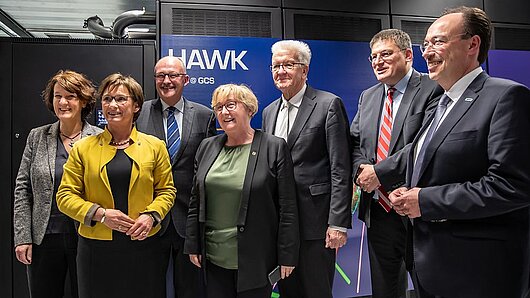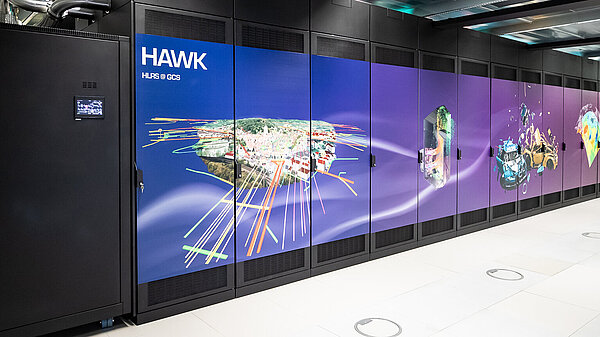High-Performance Computing Center Stuttgart

As it goes online, Hawk — a Hewlett Packard Enterprise (HPE) Apollo system with a peak performance of 26 petaflops — is among the fastest high-performance computers worldwide and the fastest general purpose system for scientific and industrial computing in Europe. It replaces HLRS's previous flagship system, Hazel Hen, offering a 3.5-fold increase in speed over its predecessor. The new power will enable scientists to tackle dramatically more complex scientific problems in the coming years.
Welcoming Hawk's "landing" at the event were high-ranking representatives of federal and state governments, including State of Baden-Württemberg Prime Minister Winfried Kretschmann, Parliamentary State Secretary of the German Federal Ministry for Education and Research Dr. Michael Meister, and Baden-Württemberg Minister for Science, Research and Art Theresia Bauer.
Also participating in the ceremony were University of Stuttgart Rector Dr. Wolfram Ressel, HPE Chief Sales Officer Heiko Meyer, AMD Corporate Vice-President of EMEA Sales Mario Silveira, SSC-Services Director Matthias Stroezel, HLRS Director Prof. Michael Resch, and Edinburgh Parallel Computing Centre Director Prof. Mark Parsons.
Speakers during the event celebrated the new opportunities for academic and industrial research that Hawk will offer, and the important role that the new supercomputer will play in supporting research at the University of Stuttgart and at academic research centers in Germany and Europe, as well as in the surrounding industrial high-tech community in Baden-Württemberg.
In his welcoming remarks, Dr. Ressel explained, "HLRS represents an essential component of the University of Stuttgart's comprehensive strategy with respect to our newly founded Excellence Cluster, 'Data-Integrated Simulation Sciences.' At the same time, however, it is not only essential for our university, but also offers scientists from around the world and experts from industry the opportunity to work together in an interdisciplinary way to use simulation to find solutions for complex problems in a wide range of areas."

Prime Minister Kretschmann welcomed Hawk as the latest tool for cementing Baden-Württemberg as a pillar of the German technological landscape, ultimately ensuring that Germany remains competitive at the international level. “We do not just find ourselves in the midst of a deep technological transformation; we are in the midst of an intensive competition,” he said. “This transformation is being driven in multiple technological sectors at once, including digitalization, quantum technologies, molecular biology, and green technologies. Our aspiration is not to run behind this technological revolution, but rather to help shape it in all its technological and cultural dimensions."
Providing an overview of Germany's national supercomputing strategy, State Secretary Meister emphasized the role that high-performance computing (HPC), at Stuttgart and at its partner national supercomputing centers in Jülich and Garching, plays in ensuring that Germany has the tools for cutting-edge research. “High-performance computing is an indispensible key technology in digitalization. It is enabling innovation in science and, what particularly impressed me, in industry.” he said.
As director of SSC-Services, a company that facilitates industrial access to high-performance computing, Matthias Stroezel spoke to the importance of Hawk's arrival for the dynamic high-tech sector in Baden-Württemberg. "(Hawk) is the prerequisite for identifying and realizing new leaps forward in innovation. HLRS is one of a kind in that it provides access to such a resource for private industry, including clients of the SSC. What an opportunity!"
The beginning of Hawk's operation also marks the beginning of a new collaboration between HLRS and HPE to develop new technologies for supercomputing. This includes the development of new software and tools for high-performance computing, for performance optimization, and for artificial intelligence that will be necessary in the coming years to prepare for the arrival of new exascale supercomputers.
"Hewlett Packard Enterprise and HLRS are a Dream Team," said Heiko Meyer. "For this reason we would like to develop a long-term development partnership with HLRS in which we optimize applications, test future technologies, and bring them to a mature, market-ready state."
Hawk is based on the EPYC Rome 7742 processor from Advanced Micro Devices (AMD). Mario Silveira, Corporate Vice President for Sales for Europe, the Middle East, and Africa at AMD, spoke about the opportunities his company gains through the partnership with HPE and HLRS in improving efficiency and performance, and making sustainability gains in its products. "We are proud to be part of this shared vision of using supercomputers to solve global challenges, and to be a partner in Hawk," he said.
Edinburgh Parallel Computing Centre Director Mark Parsons provided a broader perspective about the recent explosion in high-performance computing power and the exciting new opportunities that it offers for science and technology development, looking at applications for weather prediction, genomics research, and engineering. “Many people say, surely everything that can be done in supercomputing has been done,” he said. “Actually I would say we're at the end of the beginning. These big systems open up opportunities for science that were simply impossible before. We're going to be able to do things with them we've never managed to do before. We're at the beginning of a golden age of modeling and simulation."
Returning to future applications of Hawk's, HLRS Director Michael Resch also presented a brief overview of ways in which supercomputing can help to address key global challenges. Discussing topics including reducing air pollution, optimizing energy production in wind turbines, and developing new mobility solutions, he explained, "Hawk allows us to better understand the environment, and use these new technologies more effectively. We want to give every citizen an opportunity to be a part of these changes. With Hawk, we can digitalize the future in a sustainable way."
Following the talks, guests were able to visit the new supercomputer and learn more about how HLRS's supercomputing tools and services are having an impact.
-Christopher Williams & Eric Gedenk